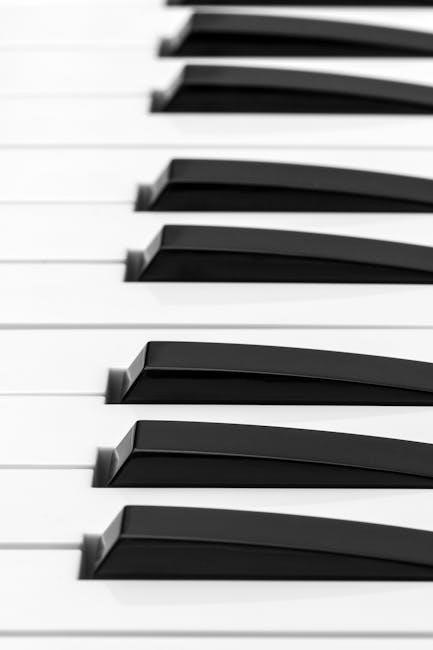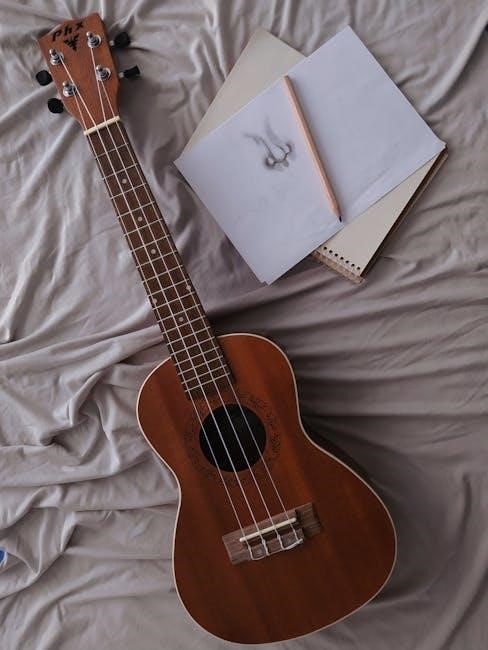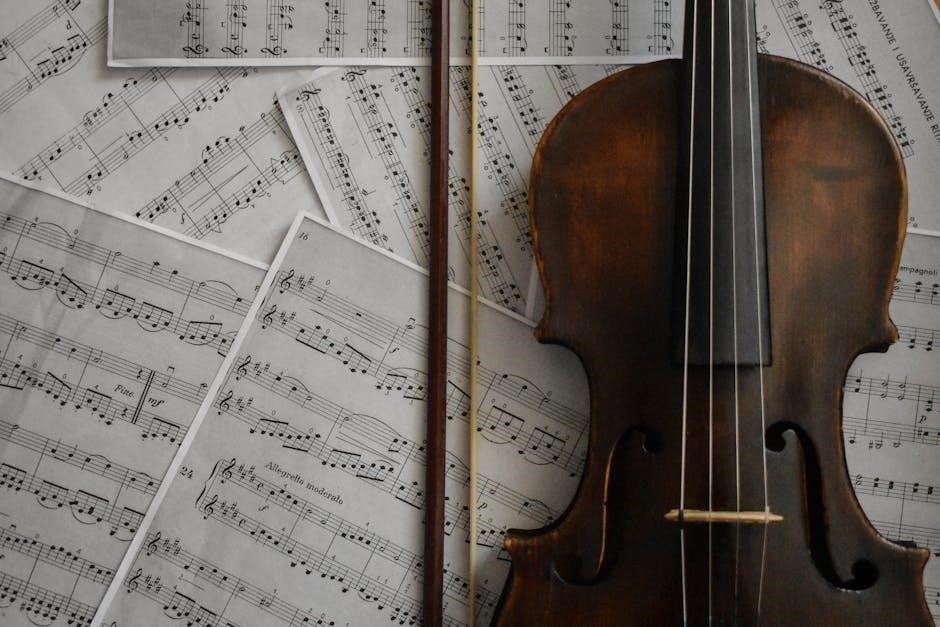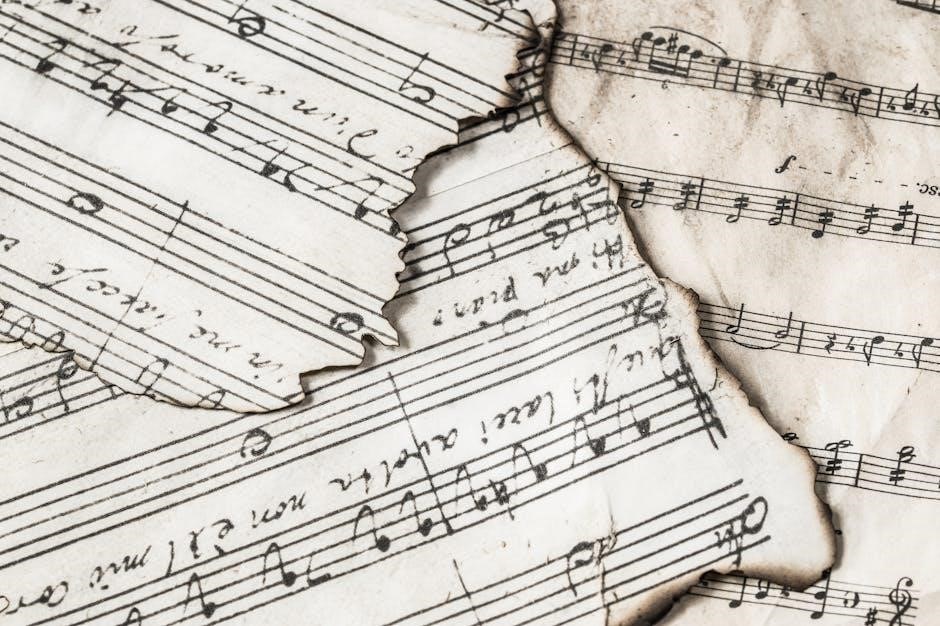“Carol of the Bells” is a beloved Christmas song with Ukrainian origins, composed by Mykola Leontovych in 1916․ It gained global fame through Peter J․ Wilhousky’s 1936 arrangement․
1․1 Historical Background
“Carol of the Bells” originated as a Ukrainian folk song, “Shchedryk,” composed by Mykola Leontovych in 1916․ It was initially performed by a choir in Kyiv and later gained international acclaim through Peter J․ Wilhousky’s arrangement in 1936․ The song’s melody was inspired by traditional Ukrainian New Year’s chants, and its title reflects the festive ringing of bells․ Over time, it became a popular Christmas carol worldwide, especially after its inclusion in the 1990 film Home Alone․ Today, it is celebrated for its hauntingly beautiful melody and rich cultural heritage, making it a staple of holiday music․
1․2 Composer and Original Version
Mykola Leontovych, a renowned Ukrainian composer, created “Carol of the Bells” in 1916 as “Shchedryk,” a piece for a cappella choir based on Ukrainian folk melodies․ The original version was part of a collection of works inspired by Ukrainian folklore and was intended for New Year’s celebrations, not Christmas․ Leontovych’s composition showcased his mastery of choral harmonies, blending traditional rhythms with a modern approach․ The sheet music for “Shchedryk” was later adapted by Peter J․ Wilhousky in 1936, introducing English lyrics and transforming it into the “Carol of the Bells” we know today․ This adaptation retained the original’s haunting beauty while making it accessible to global audiences, ensuring its enduring popularity as a holiday classic․

Sheet Music Arrangements
“Carol of the Bells” sheet music offers versatile arrangements for SATB, SAB, piano, and orchestral ensembles, available in PDF and MIDI formats for various skill levels․
2․1 SATB (Soprano, Alto, Tenor, Bass) Arrangements
The SATB arrangement of “Carol of the Bells” is a popular choice for choral performances․ It features four-part harmonies for soprano, alto, tenor, and bass voices, creating a rich and layered sound․ Many versions are available as free PDF downloads, including arrangements by Peter J․ Wilhousky and Jeanette Lampitoc․ These scores are often a cappella, emphasizing the vocal dynamics and rhythmic precision of the piece․ The SATB format is ideal for choirs, with arrangements ranging from simple to complex․ Some versions include piano accompaniment, while others remain strictly vocal․ The sheet music is widely accessible, with options for both beginner and advanced groups․ This arrangement highlights the song’s timeless appeal and versatility for choral ensembles․
2․2 SAB (Soprano, Alto, Baritone) Arrangements
The SAB arrangement of “Carol of the Bells” offers a three-part harmony, ideal for groups with fewer vocal sections․ Available as free PDF downloads, these arrangements often include piano accompaniment, blending soprano, alto, and baritone voices․ Some versions are arranged for 13 pages, featuring crescendo dynamics and a cappella sections․ The SAB format is versatile, suitable for choirs with baritone singers, maintaining the song’s rhythmic and melodic charm․ Many arrangements are designed for intermediate levels, balancing complexity and accessibility․ This version is popular for its adaptability and rich harmonic texture, making it a favorite for smaller ensembles and diverse vocal ranges․ The sheet music is widely available, ensuring broad accessibility for performers of all skill levels․
2․3 Piano Solo Arrangements
Piano solo arrangements of “Carol of the Bells” are widely popular, offering a dynamic and expressive interpretation of the piece․ These arrangements are available in various skill levels, from easy to advanced, catering to pianists of all abilities․ Many free PDF downloads provide access to simplified versions, while paid options offer more intricate compositions․ The sheet music often includes detailed notation for dynamics, tempo, and articulation, ensuring a faithful rendition of the original song․ Some arrangements feature modern twists, such as dark or contemplative interpretations, adding a fresh perspective to the classic melody․ Whether for practice or performance, piano solo arrangements of “Carol of the Bells” are a timeless choice for musicians seeking to capture the song’s haunting beauty․
2․4 Orchestral Arrangements
Orchestral arrangements of “Carol of the Bells” bring a grand and majestic sound to the piece, featuring a wide range of instruments such as flutes, piccolo, oboes, clarinets, and more․ These arrangements often emphasize the song’s dramatic dynamics and tempo changes, creating a powerful and immersive experience․ Many orchestral versions are available as free PDF downloads or paid sheet music, catering to both professional ensembles and student groups․ The intricate harmonies and layered instrumentation highlight the composition’s complexity, making it a favorite for orchestras during the holiday season․ Whether performed by a full symphony or a smaller ensemble, orchestral arrangements of “Carol of the Bells” captivate audiences with their rich and resonant interpretations․

Downloading “Carol of the Bells” Sheet Music
Download free or paid PDF sheet music for “Carol of the Bells” from platforms like MuseScore, Musicnotes, or PianoCoda․ Ensure legality by choosing reputable sources․
3․1 Free PDF Downloads
Free PDF downloads of “Carol of the Bells” sheet music are widely available online․ Platforms like MuseScore, Musicnotes, and PianoCoda offer various arrangements, from simple piano solos to complex orchestral scores․ Websites such as PDFFiller and SheetMusicArchive also provide free access to high-quality sheet music․ Many arrangements are available for SATB, SAB, or instrumental ensembles․ Users can download versions tailored to different skill levels, including easy, intermediate, and advanced․ Ensure the source is reputable to avoid copyright issues․ Always preview the arrangement to confirm it matches your needs․ Free PDFs are ideal for personal use, education, or practice, making it easy to enjoy this timeless piece without cost․
3․2 Paid Sheet Music Options
Paid sheet music options for “Carol of the Bells” offer high-quality, legally licensed arrangements․ Platforms like Musicnotes and SheetMusicPlus provide a wide range of versions, including SATB, SAB, piano solo, and orchestral scores․ These arrangements are professionally notationed and often include additional features like performance notes or backing tracks․ Paid options are ideal for musicians seeking precise, copyright-compliant materials․ Prices vary depending on the arrangement complexity and publisher․ Many sites offer previews, allowing users to review the sheet music before purchase․ Paid versions are recommended for professional performances or recordings, ensuring legality and access to premium resources; They cater to diverse skill levels, from beginners to advanced performers, making them a reliable choice for musicians worldwide․
3․3 Legal Considerations for Downloading
When downloading “Carol of the Bells” sheet music, it’s crucial to respect copyright laws․ Many arrangements are copyrighted, and downloading them without permission may infringe on intellectual property rights․ Reputable platforms like Musicnotes and SheetMusicPlus offer legally licensed versions, ensuring creators receive fair compensation․ Free downloads from unverified sources may violate copyright and expose users to legal risks․ Always verify the legitimacy of the provider and opt for paid options if the arrangement is copyrighted․ This supports composers and arrangers while ensuring compliance with legal standards․ Using licensed sheet music promotes ethical practices and avoids potential legal consequences․

Playing “Carol of the Bells”
Mastering “Carol of the Bells” requires attention to dynamics and tempo․ The Presto pace in D minor demands precise timing․ Piano arrangements emphasize rhythmic precision, while vocal performances rely on harmonious blending․
4․1 Tips for Vocal Performances

For vocal performances of “Carol of the Bells,” focus on precise harmonies and balance between parts․ Start with a strong soprano lead to guide the ensemble․ Ensure clear articulation, especially in the rapid “ding dong” passages․ Practice breath control to maintain steady dynamics, particularly during crescendos․ Blend alto and tenor voices to support the melody while allowing the bass to provide a robust foundation․ Pay attention to phrasing and diction to preserve the song’s lyrical quality․ Rehearse a cappella sections carefully to maintain pitch accuracy․ Use subtle vibrato to enhance emotional depth without overpowering the ensemble․ Finally, emphasize rhythmic precision to capture the piece’s signature drive and energy․
4․2 Piano Performance Techniques
Mastering “Carol of the Bells” on piano requires precision and dynamic control․ Begin with a steady tempo, emphasizing the rhythmic ostinato pattern in the lower registers․ Use arpeggios to create a bell-like effect, ensuring clarity in the treble․ Focus on dynamic contrasts, building from pianissimo to fortissimo for dramatic impact․ Practice hand independence to maintain the melody’s flow while accompanying with chords․ Pay attention to articulation—legato for smoother passages and staccato for crisp bell tones․ Experiment with pedaling to enhance resonance without muddying the sound․ Balance the bass and treble to maintain harmonic richness․ For advanced players, incorporate intricate fingerwork and nuanced phrasing to elevate the performance․ Regular practice will refine technique and capture the piece’s festive spirit;
4․3 Dynamics and Tempo Guidance
“Carol of the Bells” is known for its dramatic dynamics and precise tempo․ The song begins with a soft, mysterious introduction (pianissimo), gradually building to a powerful climax (fortissimo)․ The tempo is typically marked as Presto, creating a lively, energetic feel․ Dynamics play a crucial role in capturing the bell-like chime effect, with sudden shifts from soft to loud․ Musicians should maintain a steady tempo to preserve the rhythmic integrity, especially in the ostinato patterns․ Balance is key, ensuring that the melody remains clear while the accompaniment provides harmonic depth․ Proper phrasing and attention to dynamic markings will enhance the piece’s emotional impact, making it a captivating performance for both players and listeners․

Popular Versions and Interpretations

Pentatonix’s a cappella version of “Carol of the Bells” is iconic, while instrumental arrangements for piano, orchestra, and other ensembles highlight its versatility․ Modern remixes and covers add fresh twists․
5․1 Pentatonix Version
Pentatonix’s a cappella rendition of “Carol of the Bells” is a modern masterpiece․ Released in 2012, it went viral, showcasing their signature vocal harmonies and beatboxing․ The arrangement, based on Peter J․ Wilhousky’s version, features intricate layering and a powerful crescendo․ Its success topped charts worldwide, with millions of views on YouTube․ The group’s unique interpretation blends traditional elements with contemporary vocal techniques, making it a standout holiday classic․ The sheet music for this version is widely sought after, particularly for vocal ensembles, and is available for download, offering detailed parts for soprano, alto, tenor, and bass voices, as well as optional piano accompaniment․
5․2 Instrumental Arrangements
“Carol of the Bells” has been beautifully adapted into various instrumental arrangements, offering a fresh take on the classic tune․ Piano solo versions are particularly popular, with arrangements ranging from easy to advanced levels․ Orchestral renditions feature a wide array of instruments, including flutes, clarinets, and bells, creating a grand, cinematic sound․ Guitar and flute duets also provide intimate interpretations, while instrumental ensembles bring dynamic layers to the melody․ These arrangements highlight the versatility of the composition, allowing musicians of all skill levels to enjoy and perform it․ Sheet music for these versions is widely available online, including free PDF downloads, making it accessible to a broad audience․
5․3 Modern Remixes and Covers
Modern artists have reimagined “Carol of the Bells” with fresh twists, blending traditional melodies with contemporary styles․ Pentatonix’s a cappella version, for instance, showcases stunning vocal harmonies, while electronic dance remixes infuse the carol with vibrant energy․ Instrumentalists like Lindsey Stirling have crafted unique violin renditions, combining classical technique with modern flair․ These interpretations expand the song’s appeal, making it a favorite across genres․ Sheet music for these modern versions is widely available, including arrangements for piano, strings, and full orchestras․ Whether you prefer a dark piano version or an upbeat orchestral mix, there’s a modern take on “Carol of the Bells” to inspire your performance․
